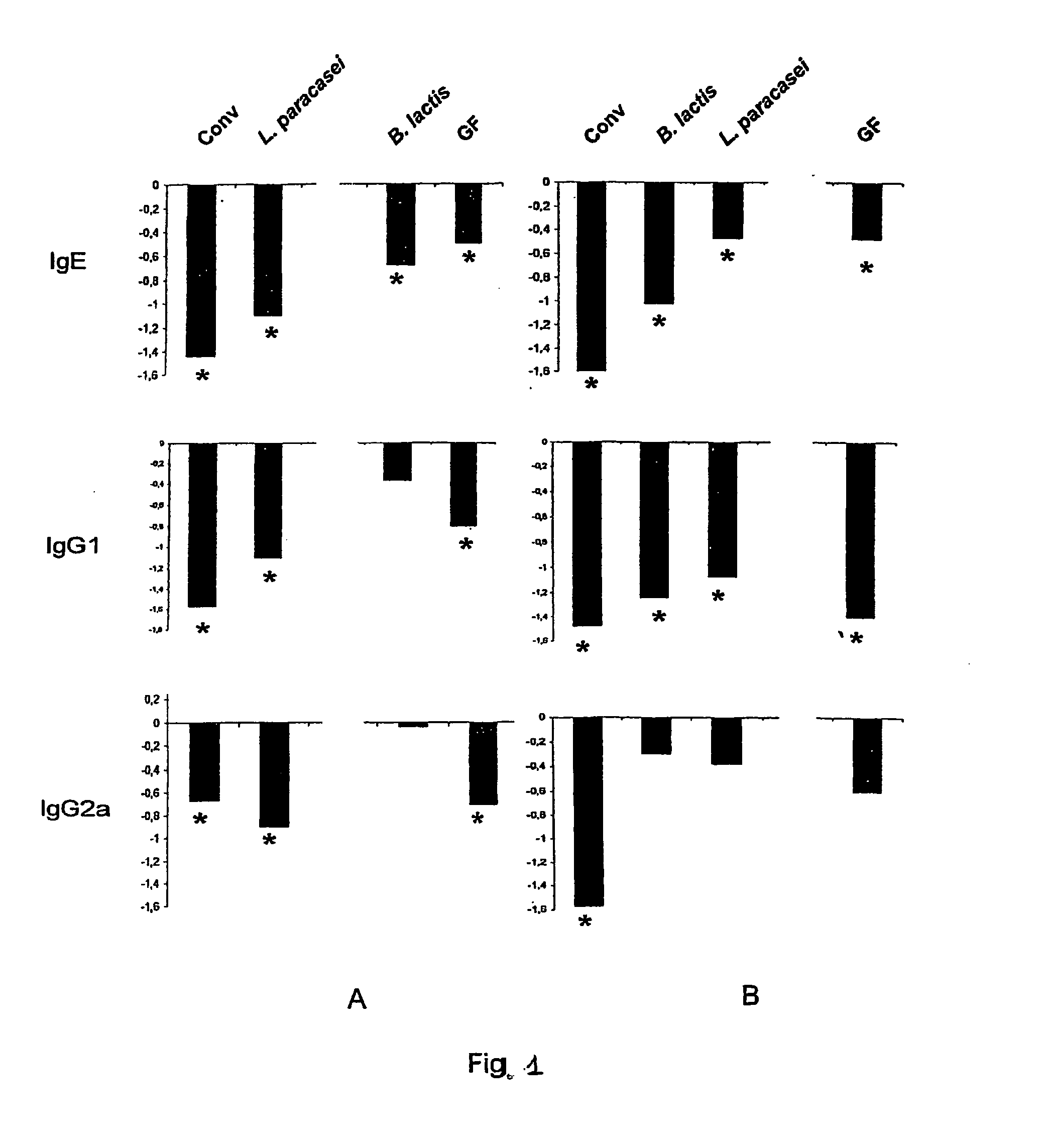Probiotics and oral tolerance
a technology applied in the field of probiotics and oral tolerance, can solve the problems of rash, hives, rash around the mouth, etc., and achieve the effect of reducing the titer of blg-specific antibodies
- Summary
- Abstract
- Description
- Claims
- Application Information
AI Technical Summary
Benefits of technology
Problems solved by technology
Method used
Image
Examples
example 1
Induction of Oral Tolerance
[0053] 3 groups of 20 germ-free female mice C3H / HeJ 3 to 5 weeks old and one group of conventional female mice BALB / c 3 weeks old were used in this exponent. Two probiotic strains were used in the study: one isolated from faces of healthy babies was from the Nestlé Culture Collection (Lausanne, Switzerland): Lactobacillus paracasei from the Nestlé Culture Collection (Lausanne, Switzerland): Lactobacillus paracasei NCC 2461 (CNCM 1-2116) and one was purchased from Chris Hansen (France) and is of human origin: Bifidobacterium lactis Bb12 NCC 362.
[0054] The germ free mice were inoculated by the oral route with an intragastric tube with 0.3 mL of a 24 hours bacterial culture containing around 5.108 cfu / mL of one out of the L. paracasei or B. lactis strains. Oral induction was induced two weeks after bacterial feeding. In each group, 10 mice were given oral administration of 3 mg / g body weight whey proteins to induce oral tolerance. Whey proteins were obtaine...
example 2
Immunosuppressive Effects of Lactobacillus paracasei NCC 2461: Incidence on Oral Tolerance Induction to Bêta-Lactoglobulin
Molecular Size of Native BLG and its TC Fractions Before and After Degradation with L. paracasei Extract.
[0059] To assess whether L. paracasei extract hydrolyzes BLG and its TC fractions, molecular size of peptides before and after degradation with L. paracasei extract was compared. Native BLG was not at all degraded by L. paracasei extract while both acidic and basic TC fractions were. Acidic peptides with high molecular weights (1000-5000 Da) were hugely degraded, releasing small peptides with molecular weighs lower than 1000 Da. Small peptides represent more than 75% of the degraded-fraction compared to 36% before, 42% of the released peptides being lower than 500 Da. The basic fraction was degraded to a lesser extent. Peptides ranging from 500 to 1000 Da decreased in the fraction to give peptides smaller than 500 Da, the latest representing 43% of the frac...
example 3
Maintenance of Oral Tolerance
[0063] The experiment is the continuation of example 1.
[0064] The maintenance of specific antibody response suppression in tolerized mice was monitored for a 7-week period after whey proteins feeding (FIG. 1). BLG-specific IgE, IgG1 and IgG2a responses were maintained suppressed in conventional mice (pL. paracasei-associated mice was not maintained, whereas both specific IgE and IgG1 levels were. A continued suppression of BLG-specific IgE responses and a significant decrease anti-BLG IgG1 titer were observed in mice colonised with B. lactis. As result, Th1- and Th2-type humoral responses were maintained suppressed in conventional mice, while only Th1-type antibody titers were maintained abrogated in germfree, B. lactis and L. paracasei-associated mice.
[0065] IFN-γ productions by spleen cells in mice sacrificed 50 days after oral tolerance induction were similar to those obtained after 28 days, except for germfree and B. lactis-associated mice for whic...
PUM
| Property | Measurement | Unit |
|---|---|---|
| molecular weights | aaaaa | aaaaa |
| molecular weights | aaaaa | aaaaa |
| molecular weighs | aaaaa | aaaaa |
Abstract
Description
Claims
Application Information
 Login to View More
Login to View More - R&D
- Intellectual Property
- Life Sciences
- Materials
- Tech Scout
- Unparalleled Data Quality
- Higher Quality Content
- 60% Fewer Hallucinations
Browse by: Latest US Patents, China's latest patents, Technical Efficacy Thesaurus, Application Domain, Technology Topic, Popular Technical Reports.
© 2025 PatSnap. All rights reserved.Legal|Privacy policy|Modern Slavery Act Transparency Statement|Sitemap|About US| Contact US: help@patsnap.com


